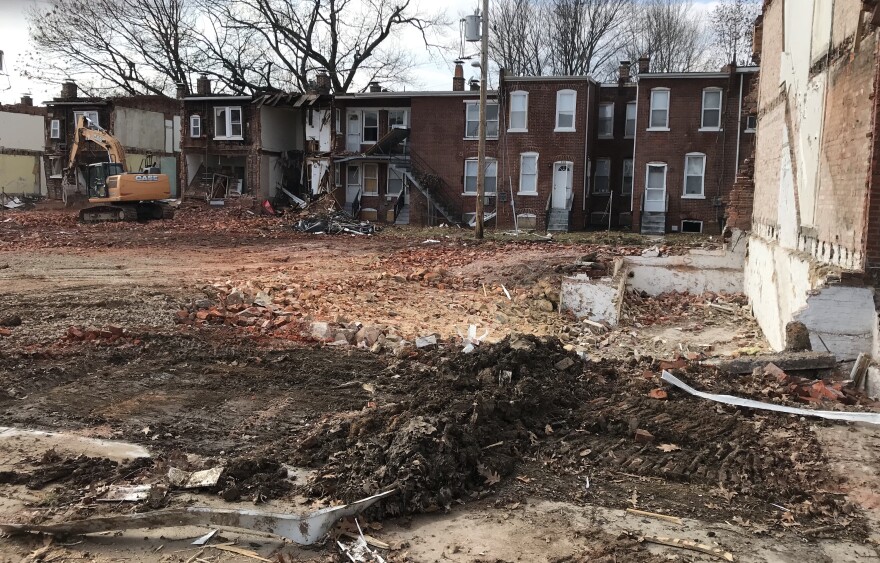With 221 new housing units in its signature redevelopment project on Wilmington’s West Side now complete, the Woodlawn Trustees are pushing ahead with the next phase of construction in The Flats and getting started on participating in Mayor Mike Purzycki’s plan to revitalize housing on the city’s East Side.
Reconstruction of The Flats, the working-class community built more than a century ago under the guidance of Quaker philanthropist and cotton-mill owner William Poole Bancroft, began in 2015 and recently reached its halfway mark with the completion of the third of its seven phases. The fourth phase has just begun, with demolition under way of existing rowhouses extending south and east from the corner of Bayard Avenue and West Seventh Street.
The 52 units in this phase – a combination of rowhouses and three-story apartment buildings – should be complete in August 2023, says Richard T. Przywara, Woodlawn’s president and CEO. Later this year construction should begin on a fifth phase, 51 units of senior housing, at Fourth Street and Bayard Avenue.

Overall, the rebuilding of The Flats will result in 453 apartment units and rowhouses. When work began, project costs were estimated at $110 million with a timeline of 10 to 15 years to completion.
The COVID-19 pandemic has brought with it construction delays and increased costs, but Przywara expects the entire project to wrap up near the end of this decade, the outer limit of the original timeline, without topping the $110 million estimate.
The pandemic slowed completion of the third phase and the start of the fourth, which Przywara had hoped to begin last August or September.

“All of us underestimated COVID,” says Przywara, who took over Woodlawn’s leadership last February. “I’ve been in construction for 25 years and I never saw anything like the last 18 months for the supply chain.”
Building materials were in short supply and, when they were available, they cost more, he says. On top of that, the virus itself and the safety protocols imposed during the state of emergency meant that fewer workers were available.
The new apartments and rowhomes in The Flats have amenities that couldn’t have been imagined when the community was originally constructed. Air-conditioned residences with roomy closets, multiple baths, dishwashers and microwaves, free WiFi connections, outdoor security cameras and off-street parking are the new normal, replacing uninsulated, energy-eating homes with tiny closets and 42-inch bathtubs.
“The old rowhouses were functionally obsolete,” Przywara says. “Many residents were paying more for electric baseboard heat than for their rent. They didn’t insulate in the early 1900s. They were paying for heating the bricks.”

The new construction does maintain much of the original character of The Flats, most notably the all-brick exteriors. And the combination of amenities like the Woodlawn Library and adjacent park and proximity to retail and dining destinations on Union Street makes the community a desirable neighborhood.
“People stay with us for many years,” Przywara says, noting that applicants may have to wait two or three years – and sometimes longer – before there’s a vacant unit available for them.
As a project funded primarily through federal low-income housing tax credits – they cover about 80 percent of the construction costs, Przywara says – The Flats is subject to complex income guidelines for its residents. Their income must fall between 30 and 60 percent of the average median income for New Castle County ($73,892 in 2019, according to the U.S. Census Bureau) and the rent they pay depends upon where their income falls within that range. The tax credit rules also require developers to allocate specific percentages of each size unit for applicants based on their income. For example, if a unit is designated for occupancy by a household whose income is 40 percent of the county median, it cannot be rented to someone whose income is at the 60 percent level.
“The old rowhouses were functionally obsolete. Many residents were paying more for electric baseboard heat than for their rent."Richard Przywara, Woodlawn Trustees' president and CEO
According to a rental web page for The Flats, the current maximum monthly rent for a three-bedroom unit is $1,026, but there are no units available.
All units in the first three construction phases are occupied. Residents from the demolished units in the fourth phase area have been relocated to other Woodlawn units and will have an opportunity to return to new units in The Flats when construction is complete.
Because The Flats is such a large community, bordered roughly by Fourth and Ninth streets on the south and north, Union Street on the east and the B&O railroad tracks on the west, it is much better known as a Woodlawn property than the scattered-site housing Woodlawn owns on Wilmington’s East Side.
Woodlawn’s interest in the East Side began in the 1930s, largely due to William Bancroft’s wife, Emma, who had been a stockholder in the Citizens Housing Corporation, a group dedicated to improving housing conditions. When she died, Woodlawn acquired her interest in the corporation and by 1960 became its sole owner. Woodlawn has gradually increased its holdings on the East Side to about 120 units, scattered throughout an area bounded by Seventh, French, 14th and Church streets.
As part of a $50 million residential redevelopment and stabilization plan announced last month by Purzycki, the city will funnel approximately $30 million into projects on the East Side. The plan includes an agreement for Woodlawn to rehabilitate 60 of the homes it currently owns and to build 20 new ones. About 20 of the homes designated for rehabilitation are vacant, and work has already begun on six of them, Przywara says.
Much of the funding for the residential rehabilitation will come from the $55.6 million the city is receiving over two years from the American Rescue Plan Act, the $1.9 trillion COVID relief package signed into law last March. “We’ll use city funds if necessary” to get the planned work done, Purzycki said this week.
Woodlawn is expected to receive about $5 million – $3 million for rehabilitation work and $2 million for the new homes, Purzycki said.
The new homes would be built on the north end of the 800 block of Bennett Street, with Habitat for Humanity of New Castle County building two rows of new homes on the south end of the block.

Przywara says Woodlawn will use the same architectural design firm as Habitat, so there will be uniformity of appearance throughout the block.
The architects haven’t begun work on interior design, Przywara says, but each unit will have two or three bedrooms, porches and energy-efficient features. Since the units will not have garages, Przywara says he hopes the architects can include exterior electrical outlets suitable for recharging electric vehicles. “Just because you live in affordable housing, you shouldn’t have to give up on other important options,” like charging an electric vehicle, he says.
Przywara says work on the new homes should start in late fall. The mayor’s office expects Woodlawn to take about three years to complete both rehabilitation and new construction.
There will be one key difference between the Woodlawn and Habitat homes: the Woodlawn units, like its other properties, will be rentals, while Habitat sells its homes to owners who invest “sweat equity” with the nonprofit during the construction stage.
While the work Woodlawn and Habitat will do is close to starting, it shouldn’t be considered a first step in the revitalization plan. “I’m anxious to go right into the balance of the East Side” to begin demolition and rehabilitation, the mayor said.
Habitat, in addition to building new homes, will partner with the city to improve the exteriors of up to 100 owner-occupied properties on the East Side, Purzycki said. The work would include roofs, trim, windows and doors, all at no cost to homeowners
Purzycki said the ambitious East Side effort requires not only a tremendous amount of resources, but unprecedented partnerships with key organizations. In addition to Woodlawn and Habitat, partners include the Wilmington Housing Authority, the Delaware State Housing Authority, the Central Baptist Community Development Corporation, the Wilmington Neighborhood Conservancy Land Bank, Delmarva Power and the New Castle County Vo-Tech School District.
“The good news here is that there will be work for everybody for years to come.”Richard Przywara, Woodlawn Trustees president and CEO
To strengthen crime-prevention efforts in the area, the utility will install 290 new and brighter streetlights. The vo-tech school district will train at least 25 neighborhood youths in the construction trades and pay them for on-the-job internships.
In addition, the state plans to fully fund construction of a new Bancroft School for grades 1-8 near the aging building at Eighth and Lombard streets. The new school would serve as an anchor to the entire revitalization program, Purzycki said.
The projects on the East Side and the ongoing revitalization of The Flats may help businesses and employees in the construction industry overcome some of the losses sustained because of the pandemic, Przywara said. “The good news here is that there will be work for everybody for years to come.”




